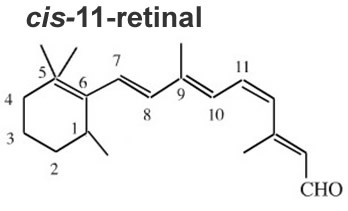Vision ability is closely related to geometric spatial isomerism cis-trans. But how does this happen?
Well retina (layer that is at the back of the eye) has a type of vitamin A, O retinal, organic compound from the group of aldehydes. The molecular structure of the retinal has a double bond between some of its carbon atoms, which allows the formation of versions cis and trans of that compound.
This cis-trans isomerization occurs when the molecule of cis-11-retinal combines with a protein, the opsin. The conformation of the cis-retinal is such that it fits into a “cavity” of the opsin, and this union gives rise to a compound called rhodopsin, which is found in the cones and rods of the retina of the eyes.

When it is in this conformation cis, the retinal is photoreceptor, that is, it is a light receiver. Therefore, rhodopsin is reached by a visible light photon, and the transformation of the isomer takes place. cis in trans, as shown below. Note that in the cis-11-retinal, the hydrogens (light gray in color) are on the same side of the double bond. already in the
trans-11-retinal, the hydrogens are on opposite sides of the bond plane:
Since the isomer trans it doesn't “fit” the opsin, it dissociates from it. With this, an electrical signal is emitted which is picked up by the optic nerve and transmitted to the brain. This electrical impulse is interpreted by the brain, producing the image.
This free isomer (trans) is converted, by enzymatic action, back into cis-11-retinal, which in turn will bind to the opsin and restart the vision process. Every second these events are repeated millions of times in our eyes.
As already mentioned, retinal is derived from vitamin A and a deficiency of this vitamin in the body can cause the person to have vision problems, such as "night blindness", in which the person has difficulty seeing at night or in poor environments. illuminated.
To avoid this type of problem, we need to consume foods that contain vitamin A, such as liver. In addition, carrots, fruits and vegetables contain beta-carotene, which can be transformed in our bodies to produce vitamin A.

By Jennifer Fogaça
Graduated in Chemistry
Source: Brazil School - https://brasilescola.uol.com.br/quimica/isomeria-cis-trans-visao.htm

